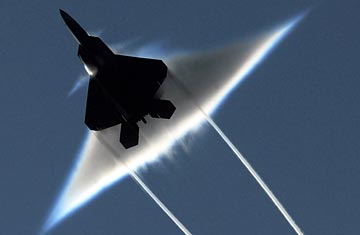
An Air Force F-22 Raptor executes a supersonic flyby over the U.S.S. John C. Stennis in the Gulf of Alaska on June 22, 2009
Supporters of building more F-22 fighters have their backs against the wall. The President, the Secretary of Defense, the Air Force leadership and the Senate's top military experts have all declared that the U.S. needs no more than the 187 of the $350 million fighters it has already bought. So the F-22's backers are changing their tactics in demanding more planes, relying on arguments from second-tier officers, citing imaginary threats and introducing the most potent argument of all these days: preserving 25,000 well-paying jobs.
The looming Senate vote over the F-22's fate is shaping up as a test of whether the U.S. will develop a cogent and balanced military force as championed by Defense Secretary Robert Gates or whether his quest will be derailed by an ad hoc coalition of entrenched interests and lawmakers whose priority is protecting the jobs of their constituents rather than the needs of protecting the nation.
The Senate is expected to vote soon on an amendment offered by Carl Levin of Michigan, chairman of the Armed Services Committee, and John McCain of Arizona, its ranking Republican, to eliminate $1.75 billion that the committee added, over their objections, for seven more F-22s (the price includes only the hardware, not the R&D, to design the planes). Those calling for an end to the plane's production note that the F-22 was designed to fight Soviet warplanes — aircraft never built by a country that no longer exists.
No F-22s have flown over Afghanistan or Iraq. That's because they were designed for long-range air-to-air duels with similarly advanced militaries. Fighters that might emerge in the future, probably flown by the Chinese, are the only prospective challengers the F-22's backers are able to cite, and President Obama believes that 187 of them are sufficient. He has pledged to use his first veto if next year's defense authorization bill contains funding for extra F-22s, knowing that losing this dogfight would doom Gates' effort to retool the Pentagon. "We do not need these planes," Obama said on July 13 in letters to Levin and McCain.
But the people building the F-22s need the jobs they generate. In the past week, three labor groups whose members help assemble the planes — the AFL-CIO, the International Association of Machinists and Aerospace Workers and the United Steelworkers — have urged lawmakers to keep them in production. With F-22 plants and suppliers spread across 44 states, there's a lot of support on Capitol Hill for keeping it in production. Senator Saxby Chambliss, the Georgia Republican who has thousands of constituents working on the planes at the Lockheed-Martin plant in Marietta, wants to keep those voters employed. He solicited a letter from the retiring head of the Air Force's Air Combat Command, who said buying just 187 F-22s puts the nation's military strategy at "high risk." An additional 60 F-22s, the general said, would ease that risk to a moderate level. Gates was not amused. "Frankly, to be blunt about it," he said, "the notion that not buying 60 more F-22s imperils the national security of the United States, I find completely nonsense."
Chambliss also sought a letter of support from the chief of the Air National Guard, who praised the F-22's "unique" capabilities and said its deployment with his reserve forces "is the most responsible approach to satisfying all of our nation's needs." Of course, the U.S. military has never been able to satisfy all of the nation's needs. Assembling a military is a balancing act, where threats are ranked and priorities set so that most of the available money is channeled toward countering the most likely threats. But so long as generals — backed by lawmakers — see it as their job to satisfy "all of the nation's needs," the taxpayers will continue buying unbelievably costly weapons to protect us from unbelievably minuscule threats.
